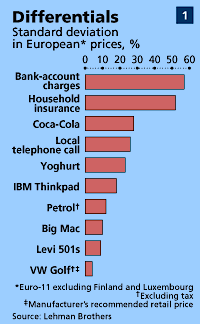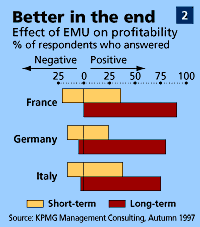
EURO BRIEF
Faster forward
The euro will hugely increase competition between firms in Europe. It will bring benefits (and profits) to many—but, as the seventh in our series argues, only the best-managed will be able to use its arrival to get ahead of their competitors
The euro
Search archive
Price transparency and the elimination of foreign-exchange costs and risks will have strategic implications in three main areas in particular: in pricing, in supplier relationships and in internal organisation and investment. This brief considers these in turn, starting with the most significant: pricing.
The price is right
Today, the price charged for the same goods varies widely between European countries. A Ford Mondeo car costs almost 50% more in Germany than in Spain; a Big Mac priced at BFr109 in Belgium costs 20% more than one at Pta375 in Spain. Whether for basic products such as ball-bearings, or for complex industrial equipment, price differentials as big as 40-50% are common. For drugs, where government intervention plays a big part, the difference between the cheapest and most expensive countries can be as big as 300%.
A recent research report prepared by Lehman Brothers, an investment bank, sampled 53 homogeneous goods across the euro area and found that, on average, prices differed from the mean by 24% (see chart 1). This price variation was twice as big as in the United States. Part of the reason is to be found in tax differences: for some goods, VAT rates, for example, vary from 20% in Finland to zero in Belgium. Transport costs can also make a huge difference to prices, particularly for bulky or heavy goods. It is also notable that price variations are smaller for tradable goods such as cameras or jeans than for less easily tradable ones such as telephone calls or bank charges.
 |
|
This is a big change compared with Europe’s existing exchange-rate mechanism, which has ensured that several intra-European exchange rates, such as the D-mark/guilder one, have been steady for many years. Despite this, comparing prices in D-marks and guilders has not been straightforward for consumers.
When consumers are able to make comparisons for themselves directly, the pressure seems likely to be for most prices to move downwards. A recent survey of big firms by KPMG Management Consulting found that 60% had significant price variations in the euro area. Of these, 64% said they expected the range to narrow; and five-sixths of these expected the adjustment to be downwards.
Yet price differences will not disappear altogether. Where they can be justified, consumers seem still to accept them. It is striking that, at the same time as the difference between the average prices paid for the same item in different countries is narrowing, the range charged within a region is increasing. An ice-cream can cost twice as much at a petrol station, for example, as when bought as part of a packet of three in a supermarket.
Chacun à son goût
Regional tastes can also make a difference, in two ways. The curd-slurping Dutch each eat nine times as much plain yoghurt as the average Irish person. The higher turnover in Dutch supermarkets is one of the reasons that yoghurt costs one-third as much in the Netherlands as it does in Ireland. And even when appetites are equally keen, tastes may differ, demanding different recipes, with different costs. The fish fingers on sale in Belgium are different from those on sale in Ireland. Such variations partly protect firms against parallel importers that buy in one market and resell in another.
Travel and education are enlarging tastes all over the continent, but regional differences remain strong. Even the new “international” cuisine finding its way on to supermarket shelves often has a strongly regional flavour: Heinz’s baked-bean pizza is unlikely ever to find favour beyond the shores of the British Isles. Without currencies to define boundaries, marketing regions will be less tied to national borders than today, following instead the logic of distribution, or of culture.
North-eastern France, for instance, might be lumped with French-speaking southern Belgium rather than with south-western France, which has more in common with the Basque region of Spain. Jan Kaas, treasurer of Unilever, points out that there are almost no Europe-wide products—even a brand such as Magnum ice-cream, which is marketed in a similar way across Europe, tastes different in different parts of the continent. Those products that are universally adored, such as Coca-Cola or Bruce Willis, tend to be global, not exclusively European.
Firms risk losing a key source of their profitability if their power to charge different amounts in different markets is eroded. Pricing strategy needs care if firms are not to throw away the profits they make through higher margins in some markets than others. In the automotive-parts business, a 1% change in price can translate into a 10-15% change in profits, according to McKinsey, a consultancy. Lehman Brothers calculates that, if all car prices in the euro area fell to the lowest levels, the revenues of France’s Peugeot-CSA and Renault groups would fall by 12% and 9% respectively.
Some advisers baldly counsel trying to fight price transparency. Possible strategems include offering complex deals that package service with a product and make it harder to compare the true costs in different places, or loyalty programmes that obscure the true value of a particular purchase. Yet it is increasingly difficult to keep customers in the dark, as communication technology sheds light on everything going on next door. American car dealers are being boxed in by customers brandishing price-lists for particular models found by searching the Internet.
McKinsey suggests that firms might try aggressively raising prices in lower-cost markets—even at the expense of lost volume there—in order to avoid a collapse to the lowest common denominator. The more that a firm can signal to its competitors that this is what it is doing, and induce them to raise prices too, the better from its point of view, although it has to avoid active collusion and the attentions of EU competition authorities. Going straight to a single euro price-list is attractive from the point of view of simple book-keeping, but it limits a firm’s room for manoeuvre in negotiating with customers. Even without moving to a single European price list, currency conversion and a period of dual labelling pose difficulties as the psychologically important threshold price-points such as 1.99 are unlikely to convert neatly into euros.
Supply and demand
The second level on which the euro will force firms to reassess their strategy is in their relationship with suppliers. Freed of the need to avoid foreign-exchange risk by buying supplies in the same currencies they are paid in, firms may choose to centralise buying from a single supplier that offers the best price or service; or they will do so merely to simplify their logistics. Greater transparency will make comparisons easier; many firms may want to try new suppliers.
A sudden rush to drop suppliers is unlikely—it would make no sense to overturn long-established relationships before the shape of the new market is clear. But over the long term, firms in the euro area are likely to reduce the number of suppliers they use.
As so often, the euro will here be accelerating something already under way. The single market, and especially the EU’s 1992 programme, have been encouraging a consolidation of suppliers already. Moreover, reducing the number of suppliers has been a practice of many American firms for years; Europeans are merely following suit.
The third level on which monetary union will have direct implications for firms is their internal structure. Until now, firms that do business across Europe have often tried to balance various operations within a single country, even at the cost of losing economies of scale. Matching supply and demand within a single country limits the risk of being caught out should the value of the guilders you receive for your chocolate, say, fall compared with the value of the francs it cost to make it.
Other differences, such as labour costs and skills, infrastructure, distribution and transport costs and regulations, will remain, slowing down progress towards a pattern of single specialised units. But in the long run, firms could enjoy tremendous economies of scale by manufacturing in a single location for the whole European market. Once again, this process has been under way for some years, boosted by the 1992 programme; but the euro will take it a stage further.
American and other firms from outside Europe may be better positioned to take advantage of the new freedom to choose locations, as they do not have the same commitment to a home country that some European firms have. Already several, such as Oracle and Microsoft, American software firms, have settled in Ireland for their main European manufacturing, taking advantage of low business costs and a talented labour force—and Ireland’s generous tax regime.
 |
|
One other aspect of internal organisation is financial. Information and communication technology has already encouraged large firms to centralise their accounting and back-office functions. This makes even more sense when dealing with a single currency. For many firms that operate in several European countries, the euro block will become their largest single market. Unilever does no more than 8% of its sales in any European market, and around 20% in its largest single market, the United States. When all 11 euro countries are added together, however, they account for more than a third of the group’s sales. Reporting results will become more transparent, both to the firm itself and to its shareholders. The euro offers tremendous opportunities for firms to simplify and streamline their operations. That is one reason why most businesses are enthusiastic about it in the long run—though in the short run many fear it may dent their profits (see chart 2). Yet all these chances will be on offer to their competitors too, so they will not provide a source of differential strategic advantage. Instead, firms will be under more pressure to distinguish themselves by excellent management. That is because another effect of the euro will be to accelerate the confrontation across borders between firms that had previously dealt mainly with national rivals. In short, most euro area businesses are in for an uncomfortable few years.